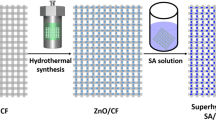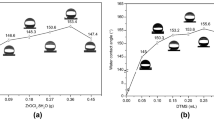Abstract
Superhydrophobic material involves the fabrication of appropriate roughness and low surface energy. Studies concerning enhancing the attachment between substrates and low surface energy material have been reported. Hence, it might also be feasible to make low surface energy material as an interface binder to enhance the attachment. In our work, the simple dip-coating method was used to fabricate polybenzoxazine (PBZ)/SiO2-coating cotton (PBZSC) fabric for rapid oil–water separation. The surface morphology and wettability of the PBZSC fabric as well as the properties of the separation were explored using various methods. These results demonstrated that PBZSC fabric not only had excellent thermal properties, but also maintained excellent superhydrophobicity (WCA > 150°) under various harsh conditions which was mainly attributed to higher surface roughness contributed by SiO2 and lower surface energy, heat resistance as well as acid and alkali resistance from PBZ resin, respectively. More importantly, the separation conducted by the PBZSC fabric not only showed great recycle property, but also separated a series of oil and water mixtures with up to 96% separation efficiency. Therefore, it is anticipated that this low-cost PBZSC fabric will be readily and widely utilized in designing multifunctional membrane for large-area oil-spill cleanup without using fluoropolymers or silicones.
Graphical abstract












Similar content being viewed by others
References
Bu Y, Huang J, Zhang S (2018) Robust superhydrophobic surface by nature-inspired polyphenol chemistry for effective oil–water separation. Appl Surf Sci 440:535–546
Caldona EB (2017) Superhydrophobic rubber-modified polybenzoxazine/SiO2 nanocomposite coating with anticorrosion, anti-ice, and superoleophilicity properties. Ind Eng Chem Res 56:1485–1497
Cao C, Ge M, Huang J (2016) Robust fluorine-free superhydrophobic PDMS-ormosil@fabrics for highly effective self-cleaning and efficient oil–water separation. J Mater Chem A 4(31):12179–12187
Cheng Y, He G, Barras A (2017) One-step immersion for fabrication of superhydrophobic/superoleophilic carbon felts with fire resistance: fast separation and removal of oil from water. Chem Eng J 331:372–382
Gao J, Huang X, Xue H (2017a) Facile preparation of hybrid microspheres for super-hydrophobic coating and oil–water separation. Chem Eng J 326:443–453
Gao S, Dong X, Huang J (2017b) Rational construction of highly transparent superhydrophobic coatings based on a non-particle, fluorine-free and water-rich system for versatile oil–water separation. Chem Eng J 333:621–629
Ge J, Qu Y, Cao L (2016) Polybenzoxazine-based highly porous carbon nanofibrous membranes hybridized by tin oxide nanoclusters: durable mechanical elasticity and capacitive performance. J Mater Chem A 4:7795–7804
Ge M, Cao C, Huang J (2018) Rational materials interface design at nanoscale towards intelligent oil–water separation. Nanoscale Horiz 3:235–260
Ishida H, Allen DJ (1996) Physical and mechanical characterization of near-zero shrinkage polybenzoxazines. J Polym Sci Part B Polym Phys 34:1019–1030
Ishida H, Hong YL (1997) A study on the volumetric expansion of benzoxazine-based phenolic resin. Macromolecules 30:1099–1106
Kim HD, Ishida H (2001) Study on the chemical stability of benzoxazine-based phenolic resins in carboxylic acids. J Appl Polym Sci 79:1207–1219
Kota AK, Kwon G, Choi W, Mabry JM (2012) Hygroresponsive membranes for effective oil–water separation. Nat Commun 3:1025–1032
Lee C, Baik S (2010) Vertically-aligned carbon nanotube membrane filters with superhydrophobicity and superoleophilicity. Carbon 48:2192–2197
Lei Z, Fevzi C (2004) Stable superhydrophobic coatings from polyelectrolyte multilayers. Nano Lett 4:1349–1353
Li S, Huang J, Chen Z (2016) A review on special wettability textiles: theoretical models, fabrication technologies and multifunctional applications. J Mater Chem A 5(1):31–55
Liu HC, Su WC (2011) Self-assembled benzoxazine-bridged polysilsesquioxanes exhibiting ultralow-dielectric constants and yellow-light photoluminescent emission. J Mater Chem 21:7182–7187
Liu H, Huang J, Chen Z (2017) Robust translucent superhydrophobic PDMS/PMMA film by facile one-step spray for self-cleaning and efficient emulsion separation. Chem Eng J 330:26–35
Macko JA, Ishida H (2000) Behavior of a bisphenol-A-based polybenzoxazine exposed to ultraviolet radiation. J Polym Sci Part B Polym Phys 38:2687–2701
Oh IK, Kim K, Lee Z (2015) Hydrophobicity of rare earth oxides grown by atomic layer deposition. Chem Mater 27:148–156
Raza A, Si Y, Wang X (2012) Novel fluorinated polybenzoxazine–silica films: chemical synthesis and superhydrophobicity. RSC Adv 2(33):12804–12811
Shang Y, Si Y, Raza A, Yang L, Mao X, Ding B, Yu J (2012) An in situ polymerization approach for the synthesis of superhydrophobic and superoleophilic nanofibrous membranes for oil–water separation. Nanoscale 4:7847–7854
Si Y, Tang X, Ge J (2014) In situ synthesis of flexible magnetic γ-Fe2O3@SiO2 nanofibrous membranes. Nanoscale 6:2102–2105
Tang X, Si Y, Ge J (2013) In situ polymerized superhydrophobic and superoleophilic nanofibrous membranes for gravity driven oil–water separation. Nanoscale 5:11657–11664
Tao M, Xue L, Liu F, Jiang L (2014) An intelligent superwetting PVDF membrane showing switchable transport performance for oil/water separation. Adv Mater 26:2943–2948
Tseng MC, Liu YL (2010) Preparation, morphology, and ultra-low dielectric constants of benzoxazine-based polymers/polyhedral oligomeric silsesquioxane (POSS) nanocomposites. Polymer 51:5567–5575
Wang CF, Su YC (2006) Low-surface-free-energy materials based on polybenzoxazines. Angew Chem 45:2248–2251
Wang CF, Wang YT (2006) Stable superhydrophobic polybenzoxazine surfaces over a wide pH range. Langmuir 22:8289–8292
Wang C, Yao T, Wu J, Ma C, Fan Z, Wang Z, Cheng Y, Lin Q, Yang B (2009) Facile approach in fabricating superhydrophobic and superoleophilic surface for water and oil Mixture separation. ACS Appl Mater Interfaces 1:2613–2617
Wen L, Tian Y, Jiang L (2015) Bioinspired super-wettability from fundamental research to practical applications. Angew Chem 54:3387–3399
Xue CH, Jia ST, Zhang J (2009) Preparation of fluoro-containing superhydrophobic cotton fabric with TiO2 sol–gel method. Dye Finish 35:1–4
Xue Z, Cao Y, Liu N, Feng L, Jiang L (2014) Special wettable materials for oil/water separation. J Mater Chem A 2:2445–2460
Yang L, Raza A, Si Y (2012) Synthesis of superhydrophobic silica nanofibrous membranes with robust thermal stability and flexibility via in situ polymerization. Nanoscale 4:6581–6587
Zhang JP, Seeger S (2011) Polyester materials with superwetting silicone nanofilaments for oil/water separation and selective oil absorption. Adv Funct Mater 21:4699–4704
Zhang X, Li Z, Liu K (2013) Bioinspired multifunctional foam with self-cleaning and oil/water separation. Adv Func Mater 23:2881–2886
Zhang W, Lu X, Xin Z (2015) A self-cleaning polybenzoxazine/TiO2 surface with superhydrophobicity and superoleophilicity for oil/water separation. Nanoscale 7:19476–19483
Acknowledgments
This work was partially supported by the National Natural Science Foundation of China (51403165), Natural Science Foundation of Hubei Province (2018CFB685, 2018CFB267), the Foundation of Wuhan Textile University and Open Project Program of High-Tech Organic Fibers Key Laboratory of Sichuan Province (PLN2016-02).
Author information
Authors and Affiliations
Corresponding authors
Rights and permissions
About this article
Cite this article
Li, Y., Yu, Q., Yin, X. et al. Fabrication of superhydrophobic and superoleophilic polybenzoxazine-based cotton fabric for oil–water separation. Cellulose 25, 6691–6704 (2018). https://doi.org/10.1007/s10570-018-2024-8
Received:
Accepted:
Published:
Issue Date:
DOI: https://doi.org/10.1007/s10570-018-2024-8




